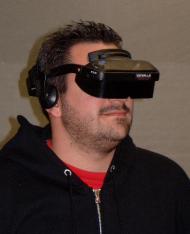HMD-less 3D
IEEE Spectrum has a very interesting article on HMD/Glass-less 3D systems on its December 2010 issue. You can read it here. The article presents past and recent efforts on creating 3D displays without using spectacle-type displays, discussing various techniques. We find the possibility of having 3D displays without the whole – arguably obtrusive – arrangement that comes with HMDs, quite fascinating. Some of the recent HMDs are indeed small and quite comfortable but at the end of the day we feel it would be more intuitive and… well, normal, not to wear them.

A not so normal pair of glasses
Nonetheless, as we understand it, the current systems work on a number of assumptions – such as distance from the screen, inter-ocular distance, posing certain usability restrictions. Among the companies mentioned Nintendo, for example, offers some adjustment for such variables in their prototypes in an effort to rectify these issues. Presumably an active (or real-time re-) calibration of the system could offer some transparency and independence to the user but that is a research subject on its own. Moreover, the techniques presented in the feature are governed – once again – by quality-cost-power consumption trade-offs, with obvious consequences on mobile usage such as portable game consoles or smart-phones. Still, the concepts are there and people keep pushing technology and that is the only way to go.
One aspect of 3D HMD displays, that the article comments on, is the ocular and non-ocular effects that often come as a result of HMD usage. In fact it is one of the aspects we on our past research efforts have examined to some extent. These issues, most often headaches and less often nausea and vomiting, are a true limitation of HMDs. Top that with with focus, luminance (for outdoor use), resolution, ghosting etc, things get messy quite fast. It is surprising – well maybe not so much if you want to be cynical – that people do not mention these limitations when talking about ‘AR-hype’ . Arguably, the focus today is on handheld mobile AR, but nonetheless these limitations are present for years and researchers have investigated them to a large extent, particularly in the context of military simulators.
We know you can not market something when you focus or mention its problems (the aforementioned cynicism…) . As UX researchers though, in a broad sense, we need to take these things into consideration if we want to produce truly immersive and commercially successful systems.

Follow Us!